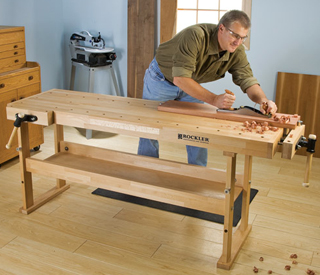
I have sifted through numerous media with the intention of finding an ergonomically correct height for a workbench. I am in the process of building a Shaker-style workbench out of hard maple, black walnut, mahogany, and red oak. It seems to me, however, that 35-1/2″ seems to be “the height” that Diefenbach, Mike Dunbar, and a host of others prefer. (An article written by Mike Dunbar talks about the 35-1/2″ bench being ergonomically correct for utilizing the big muscle groups.) I have ordered the Landis book to investigate further, but wonder if the 35-1/2″ height is something of an historical quantity? I am 5′ 11″ and a 38″ floor to bench-top bench would seem to work well.
Michael Dresdner: The right bench height involves both the height of the person working at it and the work that will be done on it. For example, guitar workbenches are adjusted so the top of the guitar is at a comfortable working height when held in its vise. This would require a different height bench than, say, one in which a one-inch thick flat board was being carved or a mortise was being chopped out. If you want to see what I feel is an ideal bench, take a look at Geoff Noden’s Adjust-a-bench, which allows you to quickly change bench heights to match the job, and the craftsman.
Lee Grindinger: Keep in mind that no one height is perfect for everything that goes on in a workshop. Many shops have benches of different heights for different types of work. My main workbench is 35″; my carving bench is 37″. I cannot exert a lot of downward pressure for an extended time against my 37″ bench; however, I can on the 35″ bench. You can and should make your bench whatever height you’re comfortable with, but if you do err it would be best if you erred by making the bench too high. Then, you can shorten the legs if you choose to.





